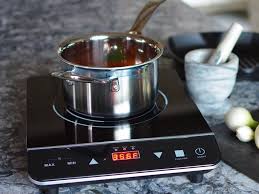What is an induction hob?

An induction hob is a hob that can be used either free-standing or as an installation in a stove. At first glance, an induction hob is hardly different from a modern glass-ceramic cooktop and a conventional ceramic hob and an induction hob can be easily confused. The reason for this is that both hobs are equipped with a glass-ceramic surface. In the switched-off state, therefore, often no difference can be detected. However, the technique used in an induction hob under the glass-ceramic surface is fundamentally different from the technique used in a conventional glass-ceramic hob.
How cooking with induction works
Like a conventional electric stove or a glass-ceramic hob, an induction hob is powered by electricity. But that’s where the similarities end because the way the food is heated is fundamentally different. Whether old-fashioned electric stove or glass-ceramic hob, both use heating coils or infrared heating elements that heat the cooking zone or the hot plate. Now place a pot or pan on the hot hotplate, the heat is passed on to the cookware and the dishes in the pot are heated.
The induction hob works quite differently. The induction does not work with heating elements and the cookware is not heated over a hot plate, but under the individual cooking zones, there are so-called induction coils. Do not heat the cooktop, but only the cookware that is placed on the hob, so that the glass-ceramic plate itself, apart from the radiation heat of the heated cookware, the cold remains. In contrast to conventional electric cooktops, the portable induction cooktop does not take the detour via a hot hotplate to heat the pot and food, but the heat goes directly from the induction coil into the bottom of the pot and the glass-ceramic surface primarily serves as a storage space for the cookware.
But how does the induction hob work exactly? Of course, this is based on the physical principle of induction and we also explain to physics muffle how the induction hob works exactly.
As already mentioned, there is a coil under the glass-ceramic surface. If the current is switched on, a magnetic field is generated there. This magnetic field by itself has no temperature and it is invisible. However, it reacts with certain substances such as some metals. The magnetic field generated by the coil under the glass-ceramic plate spreads through the plate. It does not affect the glass-ceramic plate itself and therefore the plate remains cold. However, if you place a pot or pan over the coil on the glass-ceramic plate, the pot bottom reacts with the magnetic field. The free electrons in the bottom of the pot are set in motion by the magnetic field. More precisely, the individual electrons begin to move through the magnetic field in a circular Rotation and this movement is called Eddy Current in physics. Heat is generated by the eddy currents and this heat heats the pot, which in turn heats the food. For this principle to work reliably in an induction hob, special cookware must be used, the material of which reacts with the magnetic field of the coil.
Features of a modern induction hob
Elements
Operation is possible with many induction hobs via a touch electronics. The controls are mounted directly on the glass-ceramic panel. Often all the necessary settings can be made with just one Finger and the Slider control is particularly practical and popular, where you only have to drive your Finger over a field to set the desired temperature. With particularly high-quality induction hobs, you can even find a full-fledged Touch Display on which you can make all settings. Other induction hobs have control buttons that take off for safety reasons or easy cleaning.
Timer
Timer functions are part of the basic equipment of each induction hob. Many models offer different timers such as a stopwatch, a Countdown function, a CountUp function or a short-time alarm clock. Many timers also have an off-switch function and automatically switch off the induction cooking plate after the set time has expired.
Automatic cooking zones
Automatic cooking zones are often equipped with a cooking function. After boiling or searing at a high level, the temperature is automatically lowered again. Similarly, frying sensors and cooking sensors work, which adjust the temperature to the cooking or frying process when adjusted accordingly.
Warm-up function
If the food needs to be kept warm for a while after preparation, many induction hobs provide a warm-up function. At low temperatures, the pot can simply be parked on a cooking zone and the food stays warm without boiling. The low temperatures of the hot holding function are also well suited for melting chocolate or melting Butter or other cooking processes where low temperature is required.
Booster function
Booster functions ensure that the induction hob works temporarily with more Power and performance. This makes cooking or sautéing easier, for example, and you can save a lot of time because even larger quantities of liquid can be heated faster and brought to a boil thanks to the Booster function.
Move function
Thanks to the practical move function, you can divide a surface induction cooking zone into three temperature ranges. After hot frying or boiling at high temperatures in the front zone, you can push the pot into the middle, where the dishes are cooked at medium temperature and finally push back, where they are kept warm at low temperatures. Thanks to the automatic pot detection, only the area on which the pot is located works with the Move function.
Residual heat indicator
Even if the glass-ceramic field is not heated by the induction itself, it heats up by the hot pot standing on it. The residual heat indicator shows you whether the surface is still hot and whether there is a risk of combustion.
Restart or stop&go
The phone rings, the children call or there is someone at the door and you want to interrupt the cooking process briefly? With a reStart or Stop & Go function, this is no problem, because you can put every single cooking zone into Standby with finger pressure. With further finger pressure, the cooking process continues with the previous settings. This function is also well suited for a quick cleaning in between to briefly switch off the induction hob, for example, if something is overcooked and you want to quickly wipe over the hob.
Parental
A child lock prevents curious children’s hands from turning on the induction hob or changing the settings. With modern induction hobs, it is usually sufficient to press a Sensor once to switch the parental control on and off.
Pan detection
The pot detection detects when a pot is placed on the cooking zone and switches on or off as required with the appropriate preset. This principle is used, for example, by the Move function, in which you can place the pot on a surface induction cooking zone in different temperature ranges. In some models, pot detection also means that you no longer have to manually activate the cooking zones.
Pot size detection
With the help of pot size detection, the size of the cookware is detected and the magnetic field is activated within the cooking zone marked on the ceramic hob only where the cookware stands. Often the cooking zones on the ceramic field are provided with a cross for this purpose, on which the cookware should be placed centrally. By adapting the cooking zone to the size of the pot, the energy is used very efficiently.




